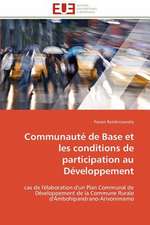Understanding Neighbourhood Dynamics: New Insights for Neighbourhood Effects Research
Editat de Maarten van Ham, David Manley, Nick Bailey, Ludi Simpson, Duncan Maclennanen Limba Engleză Hardback – 27 sep 2012
There remains a widespread belief in neighbourhood effects: that living in a poorer area can adversely affect residents’ life chances. These chapters caution that neighbourhood effects cannot be fully understood without a profound understanding of the changes to, and selective mobility into and out of, these areas. Featuring fresh research findings from a number of countries and data sources, including from the UK, Australia, Sweden and the USA, this book offers fresh perspectives on neighbourhood choice and dynamics, as well as new material for social scientists, geographers and policy makers alike. It enriches neighbourhood effects research with insights from the closely related, but currently largely separate, literature on neighbourhood dynamics.
| Toate formatele și edițiile | Preț | Express |
|---|---|---|
| Paperback (1) | 640.55 lei 43-57 zile | |
| SPRINGER NETHERLANDS – 15 oct 2014 | 640.55 lei 43-57 zile | |
| Hardback (1) | 641.71 lei 43-57 zile | |
| SPRINGER NETHERLANDS – 27 sep 2012 | 641.71 lei 43-57 zile |
Preț: 641.71 lei
Preț vechi: 754.95 lei
-15% Nou
Puncte Express: 963
Preț estimativ în valută:
122.79€ • 128.53$ • 102.20£
122.79€ • 128.53$ • 102.20£
Carte tipărită la comandă
Livrare economică 31 martie-14 aprilie
Preluare comenzi: 021 569.72.76
Specificații
ISBN-13: 9789400748538
ISBN-10: 9400748531
Pagini: 296
Ilustrații: XII, 284 p.
Dimensiuni: 155 x 235 x 22 mm
Greutate: 0.45 kg
Ediția:2013
Editura: SPRINGER NETHERLANDS
Colecția Springer
Locul publicării:Dordrecht, Netherlands
ISBN-10: 9400748531
Pagini: 296
Ilustrații: XII, 284 p.
Dimensiuni: 155 x 235 x 22 mm
Greutate: 0.45 kg
Ediția:2013
Editura: SPRINGER NETHERLANDS
Colecția Springer
Locul publicării:Dordrecht, Netherlands
Public țintă
ResearchCuprins
1: Understanding neighbourhood dynamics: new insights for neighbourhood effects research: Maarten van Ham, David Manley, Nick Bailey, Ludi Simpson and Duncan Maclennan.- 2: Understanding neighbourhood population dynamics for neighbourhood effects research: a review of recent evidence and data source developments: Nick Bailey, Helen Barnes, Mark Livingston and David Mclennan.- 3: The Causes of Long-Term Neighbourhood Change: Geoffrey Meen, Christian Nygaard and Julia Meen.- 4: How do mortgage lenders influence neighbourhood dynamics? Redlining and Predatory Lending: Manuel B. Aalbers.- 5: Urban restructuring, displaced households and neighbour-hood change: results from three Dutch cities: Hanneke Posthumus, Gideon Bolt and Ronald van Kempen.- 6: The effects of neighbourhood regeneration on the neighbourhood hierarchy of the city – A case study in Sweden: Åsa Bråmå.- 7: Neighbourhood social capital and residential mobility: Beate Volker, Gerald Mollenhorst, & Veronique Schutjens.- 8: Neighbourhood reputations, moving behaviour and neighbourhood dynamics: Matthieu Permentier.- 9: The components of socioeconomic neighbourhood change: an analysis of School Census data at varying spatial scales in England: Stephen Jivraj.- 10: How ethnic mix changes: typologising neighbourhood population dynamics of ethnic groups: Nissa Finney.- 11: Testing the racial proxy hypothesis: What is it that residents don’t like about their neighbourhood?: Karien Dekker.- 12: Community Choice in Large Cities: Selectivity and Ethnic Sorting Across Neighbourhoods: William A.V. Clark and Natasha Rivers.
Textul de pe ultima copertă
This rare interdisciplinary combination of research into neighbourhood dynamics and effects attempts to unravel the complex relationship between disadvantaged neighbourhoods and the life outcomes of the residents who live therein. It seeks to overcome the notorious difficulties of establishing an empirical causal relationship between living in a disadvantaged area and the poorer health and well-being often found in such places.
There remains a widespread belief in neighbourhood effects: that living in a poorer area can adversely affect residents’ life chances. These chapters caution that neighbourhood effects cannot be fully understood without a profound understanding of the changes to, and selective mobility into and out of, these areas. Featuring fresh research findings from a number of countries and data sources, including from the UK, Australia, Sweden and the USA, this book offers fresh perspectives on neighbourhood choice and dynamics, as well as new material for social scientists, geographers and policy makers alike. It enriches neighbourhood effects research with insights from the closely related, but currently largely separate, literature on neighbourhood dynamics.
There remains a widespread belief in neighbourhood effects: that living in a poorer area can adversely affect residents’ life chances. These chapters caution that neighbourhood effects cannot be fully understood without a profound understanding of the changes to, and selective mobility into and out of, these areas. Featuring fresh research findings from a number of countries and data sources, including from the UK, Australia, Sweden and the USA, this book offers fresh perspectives on neighbourhood choice and dynamics, as well as new material for social scientists, geographers and policy makers alike. It enriches neighbourhood effects research with insights from the closely related, but currently largely separate, literature on neighbourhood dynamics.
Caracteristici
Integrates currently separate literatures on neighbourhood dynamics and effects Includes new research findings from a range of countries and data sources Material will interest researchers and students from across the social sciences Empirical data suitable for application by policy makers






















